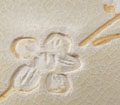J.J. Lally & Co., Oriental Art / New York City, New York
MenuPast Exhibition
The Gordon Collection:
Chinese Ceramics and Works of Art
March 12 - April 4, 2009
61.
A CUT-GLAZE DECORATED JIZHOU PORCELAIN MEIPING
Southern Song/Yuan Dynasty, A.D. 13th-14th Century
of slender tapering form, decorated on the high, rounded shoulder with a blossoming prunus branch cut through the glaze, the exposed porcelain fired to an attractive pale reddish tone on the freely incised sprig, the single prunus blossom colored chalk-white, the decoration showing a dry texture in contrast with the glossy surface of the finely crackled ivory-white tinted glaze, the short narrow neck tapering up to a small mouth, the glaze pooling slightly on the lip and around the base of the neck, the neatly pared footrim and recessed base unglazed and the exposed porcelain showing a pale reddish tone in some areas.
Height 7 1⁄4 inches (18.4 cm)
Published:
Mowry, ‘Chinese Ceramics from the Collection of Dr. and Mrs. Marvin L. Gordon,’ Orientations, March 2004, fig. 6, p.119
A plain white Jizhou meiping of identical form recovered from a ship wrecked off the coast of Korea in or shortly after A.D. 1323 is illustrated in the catalogue of the exhibition at the National Museum of Korea entitled Special Exhibition of Cultural Relics Found Off Sinan Coast, Seoul, 1977, no. 203.
A white porcelain pear-shaped vase and a covered box, both decorated in this technique, are illustrated by Medley, Yuan Porcelain and Stoneware, London, 1974, figs. 111 A, B, C, and the author describes the decorative technique on pp. 127-128. Medley suggests that a combination of methods was used. In most cases it appears that a stencil was laid down on the unglazed and still slightly damp body; the design of the stencil was cut into the body and painted with a resist; the stencil then was removed and the whole was covered with glaze. Alternatively, a paper cut-out could be stuck to the surface with adhesive, the glaze applied and the cut-out immediately removed, with further details incised as a final step.
For a complete scholarly treatment of the origins and significance of the plum blossom motif in the art of the Southern Song, see Bickford, Bones of Jade, Soul of Ice: The Flowering Plum in Chinese Art, New Haven, 1985, with a chapter entitled ‘The Flowering Plum in the Decorative Arts,’ pp. 193-243.
南宋 / 元 吉州白釉剔花梅瓶 高 18.4 厘米
